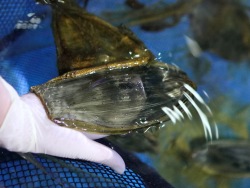Offspring in keratinous cases: zebra shark lays eggs

Zebra sharks have bred for the first time at the Primorsky Aquarium: a female shark has laid 5 eggs, and according to the biologists of the scientific and educational center, this is just the beginning. The entire spawning period may last for about 4 months during which a female is able to deposit 40 to 60 eggs.
“Our zebra sharks are about six years old; the two large predators have called the Primorsky Aquarium home since September 2018,” said Mikhail Streltsov, Head of the Tropical Marine Organisms Department. “The initial stage of the spawning process - from the emergence of fibers to laying an egg enclosed within a keratinous case – took several days, and it is normal for sharks.”
The female zebra shark has not selected a particular spawning site: scuba divers find its eggs in different areas of the Ocean Abyss – the largest fish tank of the Aquarium.
“The eggs are usually discovered near rocks”, said Sergey Pribylov, a biologist and scuba diver at the Primorsky Aquarium. “The zebra shark uses rocks for anchoring egg cases to them with adhesive fibers. The female laid one of the five eggs before our very eyes, right during the Dancing with Rays program.”
The egg cases are kept in the Ocean Abyss exhibit, in a special net cage. The embryos must develop for 4 to 6 months before they hatch, and during this period the egg cases will be monitored by the Aquarium’s biologists.
Zebra shark eggs are rather large, reaching up to 17 cm in length; hatchlings measure 20-35 cm long. Baby zebra sharks look strikingly unlike the adult individuals: they emerge with a bright, zebra-like coloration due to which the species received its common name. As sharks grow to a length of 70 cm, they gradually shed their black and white stripes for small dark spots against a light body. Because of these differences in their appearance, the young and adult zebra sharks were previously considered two separate species.
General information:
—Some one third of known shark species are oviparous.
— A shark embryo inside its egg case is supplied with a source of nourishment – a yolk sac, to which it is attached by an umbilical cord.
—Zebra sharks are capable of parthenogenesis – a reproductive strategy that involves development of an organism only from a female sex cell containing a double set of chromosomes, that is, an embryo forms without any contribution from a male. Such “virgin births” have been recorded in some individuals of this species from public aquariums in Australia and the UAE.